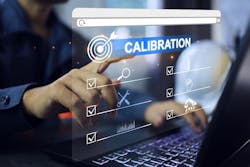Calibration instills confidence
Block, bath and pneumatic
This eight-minute video, “What is an instrument calibrator?,” covers calibrator types, such as block/dry-well for RTDS and thermocouples, fluid bath with immersed sensors, pneumatic and signal reference with regulated pressures. It also describes source and simulation modes and troubleshooting two-wire current loops.
Get your subscription to Control's tri-weekly newsletter.
Pressure eBook and videos
This online and downloadable e-book, “Fundamentals of pressure calibration,” covers accuracy versus uncertainty, precision, linearity, hysteresis, repeatability, stability versus drift, as found versus as left and other terminology, as well as reasons and how often to calibrate, locations, instruments, procedures, traceability and standards, and accredited calibrations standards.
Two Rosemount pressure videos
This four-minute video, “Rosemount 3051 pressure transmitter calibration—learn about zero, lower trim and upper trim” details the working principles of Emerson’s pressure transmitter and how to calibrate it.
It’s accompanied by a five-minute video, “Rosemount 3051 pressure transmitter—how to enter lower range value (LRV) and upper range value (URV),” that shows how to adjust and change units.
Instrument Calibration Academy
Accuracy and metrology
This online article, “Calibration: definition and importance for measuring instruments,” covers standards, processes and steps, checking and adjusting, instruments and measuring devices, accuracy and precision, and metrology’s role in quality and precision. A second article, “Calibration of pressure transmitters: the guide for accurate measurement,” covers nuances, key stages and how-to steps.
Reassurance for quality and safety
This almost 6-minute video, “Instrumentation calibration: an introduction,” shows how confidence in precise process variables enables quality products and safe operations. It demonstrates how regular calibration compares plant instrumentation to a known quantity to check for accuracy, and performs adjustments if device accuracy is outside allowed tolerances.
Vendors and bibliography
This PDF of an apparent book chapter, “Calibrations in process control” by Halin Eren, covers suppliers, definitions, errors and uncertainties, benefits, methods and procedures, personnel, laboratories, records, support software, measurement assurance planning and a bibliography.
Back-to-basics in 7 minutes
This seven-minute video, “Back to basics: calibration” by Jim Montague of Control, covers field instruments, repeatability, accuracy, misuse and misunderstandings and potential pitfalls.
Benefits and feasibility
This online article, “Automated calibration practices in process manufacturing” by Jim Shields, covers the costs, benefits and feasibility of calibration and documentation, as well as safety, quality, revenue, compliance and savings.
Baseline from before
The last version of this column, "Process calibrators have no illusions,” includes resources from Beamex, Fluke, ISA, Endress+Hauser and others.

